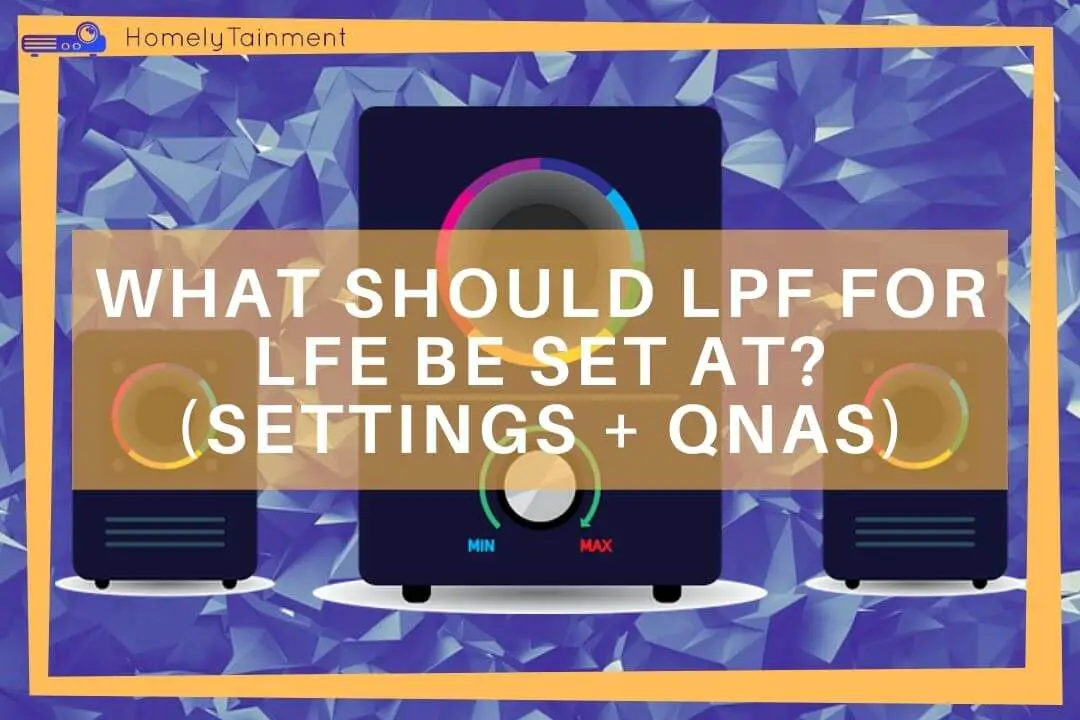
Homelytainment earn commissions (at no additional cost to you) if you purchase products from retailers after clicking on a link from our site.
The bass is the backbone of audio realism in the home theater. Perfecting it will bring many good changes to the system. Whether it is music, movies, or games, they all need that thumping effect for boosting that realism factor. So, what should LPF for LFE be set at for the maximum effects?
At A Glance: The LPF for LFE should be set to 120Hz because at this setting the subwoofer will fire accurate and deep bass. After all, the subwoofers’ drivers are not made for playing frequencies above 120Hz.
Keep reading as we will discuss many more aspects of this and I will also answer the most related questions about setting up the subwoofer.
Why 120Hz for the LPF for LFE?
The driver of the subwoofer is engineered to move back and forth slowly to create those lower-end frequencies for the deep, tight, and most accurate bass.
But if you choose the crossover for the subwoofer above 120Hz, the subwoofer will try hard to play those frequencies for which it is not engineered.
The driver will move so fast back and forth to fulfill the demand of the fed crossover settings. As a result, it will create inaccurate and shallow bass.
First, it will ruin the home theater experience. There will be little to no realism in the movies, music, and games.
Secondly, your sub will age faster, and you will have to replace your subs periodically with less time between the two periods.
Keep reading as well, and discuss the subwoofer modes and which to choose for what purpose.
Know the crossover for all the speakers in the home theater from my this post.
What Subwoofer Mode To Choose and Why?
Apart from LPF for LFE, there is a subwoofer mode as well that plays a huge role in the subwoofer experience. You should also know this if you love to listen to music on your home theater system, or if you have just a stereo setup.
What does LFE + Main do?
When the main speakers are capable of throwing bass. These speakers may be Hi-end tower speakers or Hi-fi sound speakers.
We tend to utilize its bass capabilities too with the subwoofer.
When we choose the LFE+Main in the subwoofer mode and set the main speakers to “large”.
The main speakers left and right will be used to pump up the bass, and the same bass frequencies will be copied by the subwoofer. Now, both the main speakers and subwoofer will be used for the bass.
This will give a better bass response and the theater room will be better filled by the bass.
When you are listening to stereo music the subwoofer and main speaker both will be used for bass and the same goes for home theater movies or gaming.
Read my guide about the best subwoofer for home theater. You will know about the feature of the best.
What does LFE do?
When you set all the speakers of the home theater to “small” which I recommend doing then practically there is no role of LFE to play.
But when you set any speaker to “large” then here the subwoofer will never intervene to play that speaker bass.
That set to “large” speakers is responsible for playing its bass. The subwoofer will play those speakers’ lower-end frequencies, which are set to “small”.
Keep reading as we will discuss what LFE is and 11.2 means that I am permitted to use two subs. It is a very important question to be answered.
At A Glance
| Purpose | Option |
|---|---|
| Those who want to enjoy stereo music, movies, and games in theater room | LFE+Main |
| Those who want to just watch movies and play games | LFE |
What is the LFE in the home theater?
LFE is a special channel that is dedicated to Low-Frequency Effects. This channel is responsible for playing the bass of the home theater.
No matter how many subs inputs the AV receiver provides, the signal for the LFE will be one unless the receiver is DTS:X Pro capable.
The receiver which is designed for 11.2 doesn’t mean that it has two separate signals for two subwoofers. It only means that it has two outputs for subwoofers. You can still use two subwoofers with it, and the calibration mic will set the two subwoofers with just one signal.
When you set the speakers to “small” the receiver will send those bass frequencies along with the LFE.
But if a receiver is capable of the DTS:X Pro, then the 11.2 will mean that this receiver is providing separate outputs with separate two LFE signals to the subwoofer.
Here the subwoofer performance will be enhanced.
Read my guide about are subwoofers worth it? (single vs dual). You will know why to use dual than single.
Did you get something out of this subwoofer settings guide? Hold On We Have Something Exciting To Share.
[the_ad id=”4771″]FAQs
What does LPF for LFE do?
It decides when to shift the frequencies from the subwoofer to the corresponding speakers to play those frequencies. Like if you set it to 120Hz, then the AV receiver will send frequencies above that 120Hz to the front left and right speakers to play.
The LPF for LFE is actually the frequency crossover settings for the subwoofer, but they control the LFE channel, that’s why they are dubbed LPF for LFE. Otherwise, their best-fit name will be subwoofer crossover settings.
How do I get more bass on my subwoofer?
First, you have to choose the best subwoofer with a suitable size for medium to large rooms chooses a 12-15 inches subwoofer. Now, to fill the room with a bass, you should add another sub of the same size.
The dual subs will fill the entire room and will erase the dead bass areas. After this, you will have to install acoustic panels on the wall and bass traps in the corner of the theater room. After that, soundproof the home theater to stop the outside sound from leaking into the room and the inside from leaking into the outside.
The last step will be to calibrate the entire room’s audio with a calibration mic or by an expert calibrator.
These steps will make sure that you get the most out of your subwoofers.
Should you use LFE on a subwoofer?
You should use it if you don’t want the subwoofer to play the bass frequencies of those speakers that are set to “large” in the receiver audio setting.
Speakers’ drivers are not designed to play lower frequencies, such as from 40Hz to 15Hz. These frequencies can be better played by the subwoofer. That’s why you set all the speakers to “small” but if you set a few speakers in the surround sound such as the main for stereo music to “large” then you don’t want the subwoofer to play its bass and for that, you should use LFE mode for the subwoofer.
Helpful Resources For The FAQs To Read More
- Know more about it from SVsound Blog. (Resource for the first answer)
- Get the resources links details of these steps from my post on how to optimize home theater audio. Read more about optimizing the subwoofer from Crutchfield. (Resource for the second answer)
- Know more about it from Denon Support. (Resource for the third answer)




